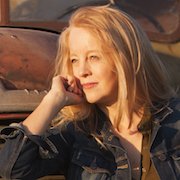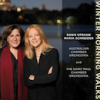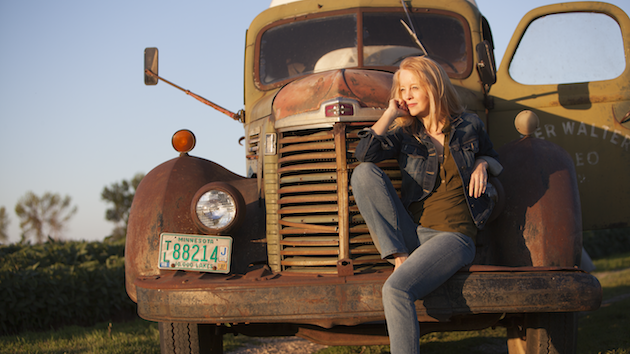
She’s a force of nature, in more than one sense.
Nature has been an abiding inspiration since early in the compositional output of Maria Schneider, and is explicitly apparent in her latest album, The Thompson Fields (ArtistShare, 2015), which provides much of what the Maria Schneider Orchestra will be performing at Zellerbach Hall on February 19. Several of the album’s tracks evoke the look and feel of either the rural North Central U.S. region of the composer’s raising, or the Catskill Mountain countryside where she and her partner, Mark, seek refuge outside her base of activity in New York City.
But Schneider, an ever-fresh-faced 56-year-old, is herself a muse with an infectiously forceful nature, expounding over the phone about both music-making and topical advocacy as she consumes a luncheon of dandelion greens. “I’ve got too much going on, I’m spinning too many plates,” she giggles between bites. Having successfully financed her own recordings through ArtistShare, an online crowdfunding platform, Schneider seeks “transparency and fairness” from both recording and streaming companies, to assure that composers, songwriters, performers, and producers benefit financially from their creative work.
Schneider reports that many of her musician friends, in the era of easily available streaming music, have seen their royalties decline “by 90 percent or more. Yet our music is more exposed. You go on YouTube, people are seeing more people listening to their music than ever before. But they’re listening for free! And most of that free stuff has been put up illegally.” Her own experience has revealed a collateral problem, that videos “put up … without my permission … by a student ensemble playing my music” may not be “representative of what I want to put out there. When I make a recording which I represent to the public as mine, I spend months and months working all the details,” as well as some 200 thousand dollars on a big band project, “and that doesn’t include that I haven’t paid myself.”
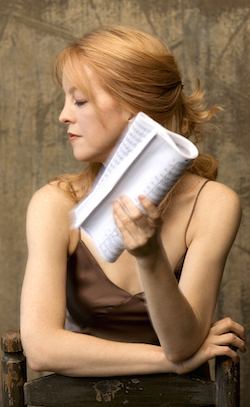
Companies like YouTube and Spotify “are making millions of dollars off this sort of stuff — through gathering data, through advertising, through being the go-to place,” Schneider continues. “Why is capitalism good for everyone else in America, except for the musicians? I think I should be able to control my work — I’m protected by copyright — and I should be able to set my prices.”
She has no problem finding fellow advocates for her cause, across genres. “We’re about 2,600 strong now and we have a wide variety of people,” among them Carole King, Stephen Sondheim, John Corigliano, and Steve Reich, “and many student musicians, because this is their future. They’re starting to wake up from the purple Kool-Aid coma they’ve been in, they’ve all been seduced by this idea that giving music for free wins them fans, gets them publicity. But if you train the world to get everything for free, then you can’t monetize what you do, and you’ll no longer be able to do it.”
Schneider has testified about these matters before Congress, on behalf of The Recording Academy (formerly the National Academy of Recording Arts and Sciences, which awards the Grammys) and has helped launch musicanswers.org, committed “to reclaim and protect our rights in the digital age.” She notes that some high-profile pop stars “who are streaming and doing well … for the most part are being given huge advances from Spotify, [but] name one jazz or classical record which has come even close to paying for its budget through streaming. Nobody could name one.”
As a result, “a lot of musicians have to do something on the side, to keep making their music,” while Schneider, though technically a full-time musician, is “putting a lot of time into fighting these issues, and it’s cutting into my creativity. When some issue touches my heart and my consciousness and my sense of right and wrong, I’m like a dog on a bone. Some days I’m like, I gotta let this go, let somebody else fight it, but I can’t unlock my jaw on it, because it’s wrong!”
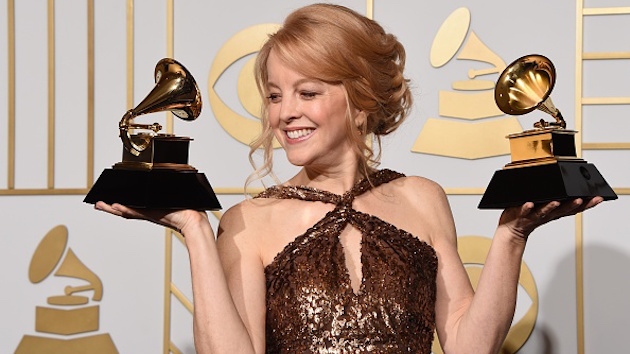
Schneider’s heart is also audible on The Thompson Fields, which won a 2016 Grammy Award. “The music is so tied to my [original] home in Minnesota, and to my love of nature, and to everything that was important to me growing up and still is,” she states. These themes played out affectingly in the look of the album, as well as in the sound. “At a farmer’s market, outside of Manhattan, I met a woman, Cheri Dorr, who told me she was a designer and would like to work on one of my projects. I also met a woman from San Francisco, a friend of the daughter of my partner Mark, who in her twenties was already this unbelievably mature, insightful photographer, named Briene Lermitte.
“I brought Briene out to Windom [Schneider’s Minnesota hometown] to take pictures of the Thompson farm, where I’d spent a huge amount of my childhood. We ended up making what’s almost like a little coffee table book,” artfully assembled and embellished by Dorr in CD album format. “I thought, ‘when everybody is going cheaper, because nobody seems to want CDs any more, I’m gonna do the opposite. It’s gonna be expensive, but I’m gonna put my faith in it, and people are gonna appreciate this, especially in a time like this.’ And I think it really happened.”
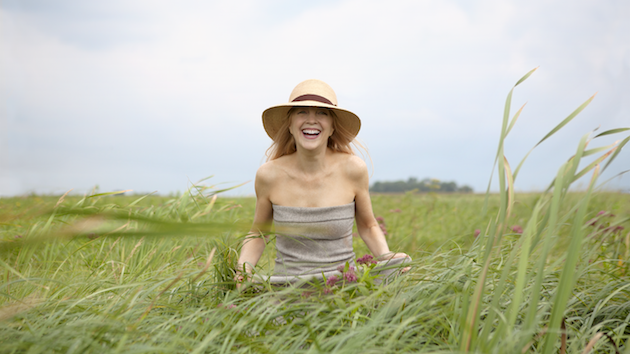
Schneider describes her family and the Thompsons as having been “closest friends,” as well as neighbors. “And they were not only farmers, but huge lovers of nature, so they protected native prairie and wetlands … and were really into the preservation of wildlife habitat and native plants,” pictured by Lermitte on the album’s pages and thrillingly evoked by Schneider’s voicings and her painterly deployment of the eighteen instrumental members of her ensemble. “One of the sons [Tony Thompson] holds the AgroEcology Summit every year, and I still go back for that. One time I climbed to the top of his silo and we looked out over those fields. The wind was blowing, the beans were moving like waves, and we were just remembering. So many of the people that were important to me when I was young have died, so there’s also a sense of nostalgia [on the album] and appreciating, in this wide-open landscape, this incredibly strong sense of community.”
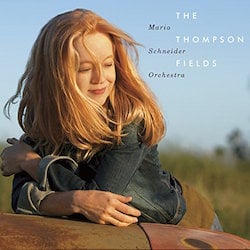
For the album’s first track, “Walking By Flashlight,” Schneider drew on her earlier setting of a poem by Ted Kooser (“from that part of the country I’m from”) for operatic and art song soprano Dawn Upshaw and the Australian Chamber Orchestra, included in a collection of songs on the album Winter Morning Walks (ArtistShare, 2013), another Grammy winner. “I adapted three of the [songs] for my [jazz] band,” notes Schneider. How might the adaptation differ from the original, classical setting? “The lines get so blurred,” she admits, “but what makes my jazz music jazz is, it couldn’t be played by non-jazz musicians, because it has that element of risk-taking and improvisation. Every time the band plays, they play things completely differently. And if somebody takes a solo in a risky way, you can trust somebody else to bring it home again.”
In another transcending of imagined fences between genres, Schneider agreed to work with David Bowie, soon after the pop icon had been diagnosed with the liver cancer which ended his life. “He came over with his demo of the beginning of a song, I listened, sat at the piano and played around a little, worked on it for a couple of weeks, and we got back together and went over all the directions this could take. He sat next to me, singing and trying things; it was really fun! And he expressed to me that he’d always loved jazz — Stan Kenton, Milt Jackson, and [Schneider’s mentor and former employer] Gil Evans — and that he’d been listening to my band for years.”
At the onset of the collaboration “I was nervous and scared that I wouldn’t contribute something he’d like. We’re from such different worlds, but he was so nice and so open. We put together a little rehearsal with a few musicians, then we pretty much knew what we wanted, except that he changed the lyrics to the song, to be very dark.” “Sue (Or in a Season of Crime),” featuring the Maria Schneider Orchestra, was included on the Bowie career compilation album Nothing Has Changed (2014) as well as on Blackstar, released two days before Bowie’s death in January of 2016. (The song won a 2016 Grammy for Best Arrangement, Instruments and Vocal.) “He wanted to do more things, he had another song,” Schneider recounts, “but I was just getting ready to record The Thompson Fields, so I had to say, ‘I can’t.’”
Along with seeking the peacefulness of her property in Sullivan County, Schneider also enjoys journeying further north, to the Cornell Lab of Ornithology in Ithaca, which she serves as a board member. “I’ve restarted birdwatching, which I’d done as a kid,” she explains. “And at our place, I brought in a native plant person to advise me how to bring more birds in. I’ve been pulling the invasive weeds and planting more native plants and we have so many species of nesting birds now, it’s astounding, the most joyful thing in my life, along with having Mark in my life, giving myself the space to enjoy and love life. All these things affect my music.”
There are also occasional flights, though fewer than before, to work with European ensembles, and residencies in Wisconsin and elsewhere across the country, where she’s encouraged by heightening awareness of a variety of ecological and other issues. “Suddenly everybody’s waking up and alarmed, and getting politically active,” she observes, “and I think we’re gonna see a culture that’s scared of what they’re losing but feels that their voice matters.”
She turns to Bowie as a beacon. “If David left all of us in this world with anything,” she says, “it was that we should all approach our lives with the fearlessness and ferocity that he did.”

